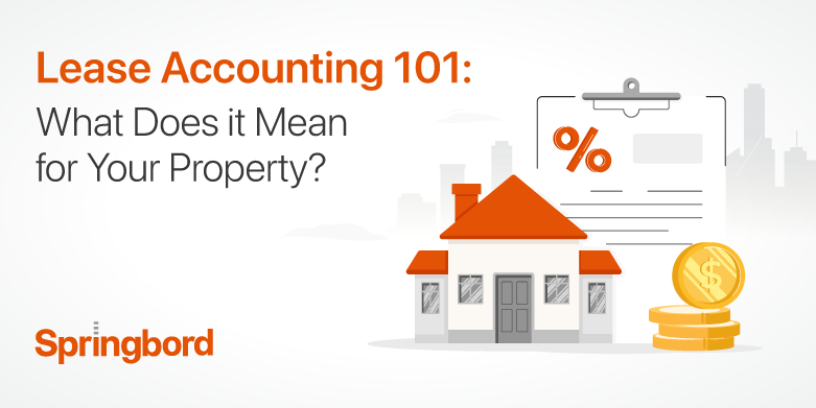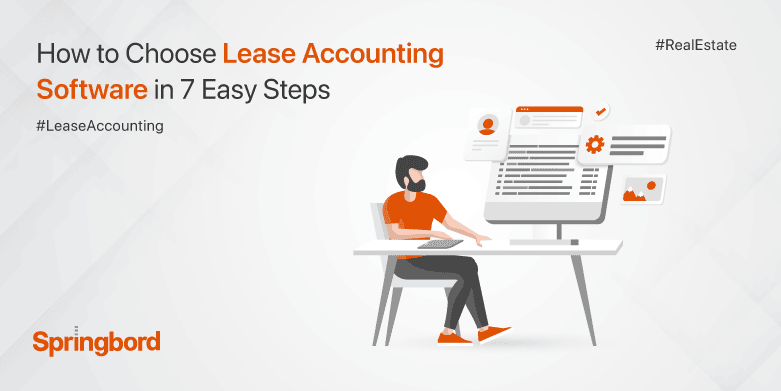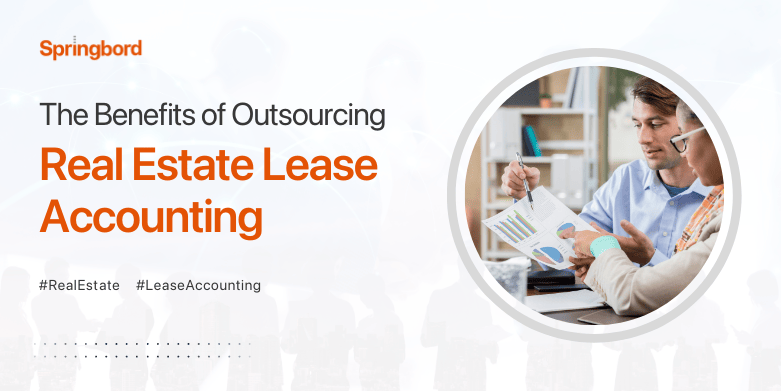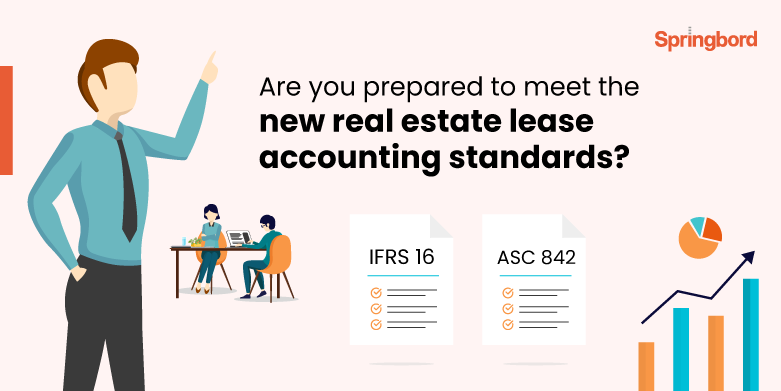 Read time 6 min
Read time 6 minLease accounting, particularly with the implementation of ASC 842 and IFRS 16, is critical for property owners as it transitions how leases are recognised on financial statements, bringing transparency to financial commitments.
These standards require nearly all leases to be included on the balance sheet, reflecting true liabilities and assets, which affects stakeholders’ view of a company’s financial health. This blog explores the implications of these changes, offering strategic insights for compliance and financial optimisation.
For expert guidance, Springbord’s specialised real estate bookkeeping services provide crucial support in adapting to these new lease accounting standards.
Why Lease Accounting Matters to Property Owners?
Lease accounting is crucial for property owners because it affects how leases are reported on financial statements, influencing key metrics like profit, debt levels, and operational costs.
Recent changes in accounting standards—specifically ASC 842 and IFRS 16—have made it essential for property owners and business operators to understand these regulations to manage their portfolios effectively.
Financial Implications and Business Impact
The adoption of these new standards has had a profound impact on how companies report their financial status. For instance, with the implementation of IFRS 16 and ASC 842, companies must now include lease obligations on their balance sheets, which significantly changes reported assets and liabilities.
This change enhances the transparency of financial reporting but also requires companies to update their accounting processes and systems. It’s estimated that prior to these changes, public companies had about $1.25 trillion in off-balance sheet lease obligations.
At Springbord, our real estate bookkeeping services are designed to help property owners navigate these changes smoothly. With expertise in both ASC 842 and IFRS 16, Springbord offers tailored solutions that ensure compliance and optimise financial reporting.
Understanding the New Lease Accounting Standards: ASC 842 and IFRS 16
Lease accounting has significantly shifted with the introduction of ASC 842 and IFRS 16, marking a pivotal change in how businesses, particularly property owners, recognise and report their leasing activities.
These standards were developed to enhance transparency and comparability by ensuring that leases are recorded on the balance sheet, providing stakeholders with a clearer view of a company’s financial obligations.
Key Changes from Previous Standards
Previously under ASC 840, leases were classified as either operating or capital leases. Capital leases were recorded on the balance sheet, while operating leases were not, leading to significant off-balance sheet financing.
ASC 842 eliminates this distinction for lessees, requiring both types of leases to be recognised on the balance sheet. This change brings U.S. standards closer to international standards, which have historically been more stringent about lease reporting.
IFRS 16 replaces the IAS 17 standard and similarly requires lessees to recognise lease assets and liabilities on their balance sheets. One of the most impactful changes under IFRS 16 is the removal of the classification of leases as either operating or finance (similar to capital leases under U.S. GAAP). Instead, all leases are treated in a similar manner to finance leases.
Why do These Changes Matter?
The shift to putting most leases on the balance sheet is intended to provide a more accurate picture of a company’s liabilities and assets. This change impacts various stakeholders:
- Investors and Analysts: Better visibility into the company’s financial leverage and capital employed.
- Creditors and Lenders: A more transparent view of a company’s obligations, affecting credit assessments.
- Management: Enhanced ability to manage lease portfolios and make informed decisions regarding leasing strategies.
At Springbord, our specialised real estate bookkeeping services are designed to ensure seamless compliance with new lease accounting standards, leveraging our expertise to optimise financial strategies and maintain detailed and accurate financial reporting.
Our support helps clients adapt to these new requirements effectively, enhancing their capacity to manage financial risks and opportunities associated with their lease portfolios.
Impact on Financial Statements
The adoption of ASC 842 and IFRS 16 fundamentally alters the way companies report leases in their financial statements. This shift not only affects the balance sheet but also impacts the income statement and cash flow statement.
Understanding these changes is crucial for property owners and managers to accurately assess their financial health and make informed business decisions.
Balance Sheet
Under ASC 842 and IFRS 16, leases previously classified as operating leases now appear on the balance sheet. This means that both a right-of-use (ROU) asset and a corresponding lease liability must be recorded.
For property owners, this change increases both assets and liabilities, impacting key financial ratios such as the debt-to-equity ratio and return on assets (ROA).
Pre-Implementation Example: ASC 840
- Operating Lease: Off-balance sheet. Lease payments are recorded as an operating expense.
- Capital Lease: Asset and liability recognized on the balance sheet.
Post-Implementation Example: ASC 842
- All Leases (over 12 months): Recognized on the balance sheet. Both ROU assets and lease liabilities are recorded.
Income Statement
The new standards require that lease expenses be split between the amortisation of the ROU asset and interest on the lease liability.
This change primarily affects the timing and classification of lease expenses.
Pre-Implementation Example: ASC 840
- Operating Lease Expense: Recorded as a single line item under operating expenses.
Post-Implementation Example: ASC 842
- Lease Expense: Divided into amortisation (depreciation of the ROU asset) and interest expense on the lease liability.
Cash Flow Statement
The cash flow statement sees the reclassification of lease-related cash flows under the new standards.
Pre-Implementation Example: ASC 840
- Operating Leases: Entire lease payment recorded under operating activities.
Post-Implementation Example: ASC 842
- Finance Leases: The principal portion of the lease payment is recorded under financing activities; the interest portion is recorded under operating activities.
- Operating Leases (IFRS 16): Total lease payments typically recorded under operating activities.
At Springbord, our detailed analysis and expert advice help clients optimise their financial statements and maintain regulatory compliance. Contact Springbord today to see how we can assist you.
Strategic Implications for Lease Negotiations
The implementation of ASC 842 and IFRS 16 has profound implications for how leases are structured and negotiated.
Property owners and business managers must now consider the balance sheet impact of lease terms, which affects financial metrics and reporting.
How New Standards Affect Lease Terms and Negotiations
The requirement to recognise almost all leases on the balance sheet under ASC 842 and IFRS 16 means that lease obligations are more transparent.
This increased visibility impacts various aspects of lease negotiations:
- Lease Term: Longer lease terms result in higher liabilities recorded on the balance sheet. Consequently, companies may prefer shorter lease terms to minimise reported liabilities. However, shorter terms can lead to higher lease costs and more frequent renegotiations.
- Lease Payments: Structuring lease payments to be lower in the initial years can be beneficial as it reduces the front-loaded expense impact on the income statement. However, this may not always align with the lessor’s preferences.
- Renewal Options: Including options to renew or terminate leases can offer flexibility and potentially beneficial accounting treatment. However, these options must be assessed carefully to ensure they align with the overall strategic goals and financial impact under the new standards.
Tips for Structuring Leases under New Regulations
1. Optimize Lease Terms
- Balance Lease Duration: Weigh the trade-offs between longer and shorter lease terms. Shorter terms can reduce balance sheet impact, while longer terms offer stability and potentially lower rates.
- Renewal and Termination Options: Structured options provide flexibility without significantly increasing liabilities. Deloitte suggests that these options help manage lease terms and financial implications effectively.
2. Negotiate Favorable Lease Payments
- Front-Loaded vs. Even Payments: Manage financial statement impact with payment structuring. Front-loaded payments might increase initial expenses but offer long-term benefits, while even payments simplify financial planning.
- Variable Lease Payments: Use performance-based variable payments, which may not need to be capitalised, thus reducing balance sheet liabilities.
3. Consider Sale and Leaseback Arrangements
- Capital Release: These arrangements free up capital by selling an asset and leasing it back. Under ASC 842, these must meet specific criteria to be recognised as a sale; otherwise, they’re treated as financing.
- Financial Flexibility: Provides liquidity while maintaining asset use, enhancing financial flexibility.
4. Utilize Professional Expertise
- Engage Advisors: Financial and legal advisors can help navigate the complexities of ASC 842 and IFRS 16, optimising leases for financial outcomes and compliance.
- Leverage Technology: Use lease accounting software for effective management, ensuring accurate reporting and compliance, and integrating with existing financial systems
Springbord’s team of experts helps clients structure leases to optimise financial positioning, ensuring compliance with ASC 842 and IFRS 16.
We leverage advanced tools and deep industry knowledge to assist in making strategic decisions that align with your financial goals.
Conclusion
The transition to ASC 842 and IFRS 16 significantly impacts how property owners report leases, bringing enhanced transparency and comparability to financial statements.
By understanding these changes and strategically structuring lease terms and payments, businesses can optimize their financial positioning and compliance.
Adapting to these new standards is essential for maintaining accurate financial health and leveraging lease portfolios effectively.
At Springbord, our lease accounting service is designed to help you navigate these complexities with ease. Our team of experts provides tailored solutions that optimize your financial reporting and strategic planning.
We assist you in understanding the implications of these standards, ensuring that your lease accounting practices are not only compliant but also beneficial for your overall financial strategy.







